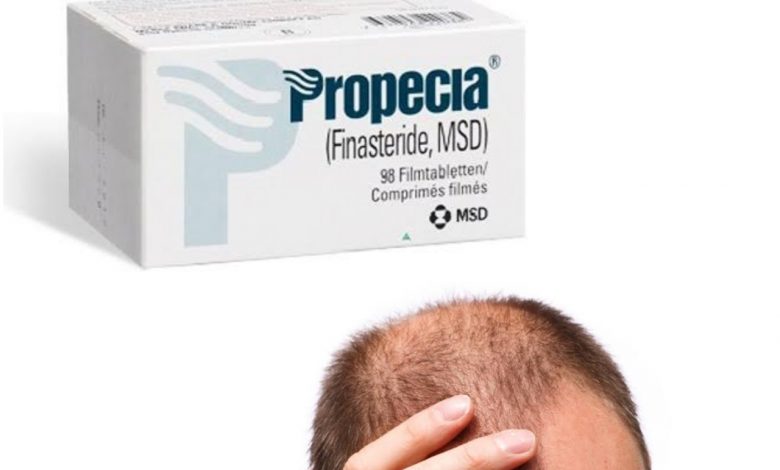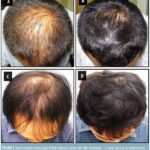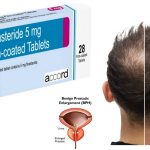Finasteride Shedding: Why it Happens and What It Means, Pictures

What is male pattern hair loss?
Male pattern hair loss is an inherited condition, caused by a genetically determined sensitivity to the effects of dihydrotestosterone (DHT) in some areas of the scalp. DHT is believed to shorten the growth, or anagen, phase of the hair cycle, from a usual duration of 3–6 years to just weeks or months. This occurs together with the miniaturization of the follicles and progressively produces fewer and finer hairs. The production of DHT is regulated by an enzyme called 5-alpha reductase.
Several genes are involved, accounting for differing ages of onset, progression, patterns, and severity of hair loss in family members. The susceptibility genes are inherited from both mother and father. At this time, genetic testing for the prediction of balding is unreliable.
A few women present with male pattern hair loss because they have excessive levels of androgens as well as genetic predisposition. These women also tend to suffer from acne, irregular menses, and excessive facial and body hair. These symptoms are characteristic of a polycystic ovarian syndrome (PCOS) although the majority of women with PCOS do not experience hair loss. Less often, congenital adrenal hyperplasia may be responsible. Females that are losing their hair with age are more likely to present with female pattern hair loss, in which hormone tests are normal.
What is Finasteride?
Finasteride, also known by the brand name Propecia is used to treat male pattern hair loss (gradual thinning of the hair on the scalp, leading to a receding hairline or balding on the top of the head in men.) Finasteride (Propecia) has not been shown to treat thinning hair at the temples and is not used to treat hair loss in women or children.
How finasteride works
Finasteride is in a class of medications called 5-alpha reductase inhibitors. Finasteride treats BPH by blocking the body’s production of a male hormone that causes the prostate to enlarge. Finasteride treats male pattern hair loss by blocking the body’s production of a male hormone in the scalp that stops hair growth.
How to take finasteride
All possible dosages and forms may not be included here. Your dose, form, and how often you take it will depend on:
• your age
• the condition being treated
• how severe your condition is
• other medical conditions you have
• how you react to the first dose
Dosage for male pattern hair loss
Generic: Finasteride
• Form: oral tablet
• Strengths: 1 mg
Brand: Propecia
• Form: oral tablet
• Strengths: 1 mg
Adult dosage (ages 18 years and older)
• Typical dosage: 1 mg per day.
Child dosage (ages 0-17 years)
Dosage for people younger than 18 years has not been established. This drug is not prescribed for use in children.

What is finasteride shedding?
Finasteride shedding is one of the positive signs that indicate the medication is working for your hair loss. It involves hair falling out at a faster rate when you initially begin to take the medication. Finasteride works by preventing testosterone from being converted into DHT by the enzyme 5-alpha-reductase.
Finasteride Shedding allows older hairs to fall off, making way for newer and stronger strands of hair to grow. When you take finasteride as prescribed by your doctor, you will experience shedding within the first few months of your plan. However, some men may notice shedding even earlier, with damaged hairs quickly making way for stronger strands.
Finasteride Results Timeline: What to expect
0-3 months: Within the first 3 months of using finasteride, you can expect to see hair shedding. This is normal and a sign that finasteride is working. The older hairs are shedding and making way for newer healthier strands of hair. These hairs will remain in the resting phase for a longer period of time, eventually giving a fuller and thicker appearance to your hair.
3-6 months: Finasteride results after 6 months are usually more prominent and noticeable. It is within the 3-6 month period that you should start to notice bald patches filling up, and less hair falling out. There should be an overall improvement in the appearance of your hair.
6-9 months: After 9 months, your hair follicles have had plenty of time to produce newer and healthier hair. Your hair should not be failing out at the rate it did before taking finasteride.
9 months – 1 year: After 1 year of using finasteride, there should be either a noticeable improvement in the appearance of your hair or you should be losing hair at a slower rate than before. If you have not noticed an improvement after one year, it is unlikely that finasteride will work for you.
What are the side effects of finasteride?
Side effects requiring immediate medical attention
Along with its needed effects, finasteride may cause some unwanted effects. Although not all of these side effects may occur, if they do occur they may need medical attention.
Check with your doctor immediately if any of the following side effects occur while taking finasteride:
More common
• Chills
• cold sweats
• confusion
• dizziness, faintness, or lightheadedness when getting up suddenly from a lying or sitting position
Less common
• Bloating or swelling of the face, arms, hands, lower legs, or feet
• breast enlargement and tenderness
• hives or welts, itching, skin rash
• rapid weight gain
• redness of the skin
• swelling of the lips and face
• tingling of the hands or feet
• unusual weight gain or loss
Incidence not known
• Clear or bloody discharge from the nipple
• dimpling of the breast skin
• inverted nipple
• lump in the breast or under the arm
• persistent crusting or scaling of the nipple
• redness or swelling of the breast
• sore on the skin of the breast that does not heal
Side effects not requiring immediate medical attention
Some side effects of finasteride may occur that usually do not need medical attention. These side effects may go away during treatment as your body adjusts to the medicine. Also, your health care professional may be able to tell you about ways to prevent or reduce some of these side effects.
Check with your health care professional if any of the following side effects continue or are bothersome or if you have any questions about them:
More common
• Decreased interest in sexual intercourse
• inability to have or keep an erection
• loss in sexual ability, desire, drive, or performance
Less common
• Runny or stuffy nose
• sleepiness or unusual drowsiness
• sneezing
Less common or rare
• Back pain
• decreased amount of semen
• diarrhea
• dizziness
• headache
• stomach pain
Incidence not known
• Testicular pain
Taking finasteride may increase the risk that you will develop high-grade prostate cancer (a type of prostate cancer that spreads and grows more quickly than other types of prostate cancer) or breast cancer. Talk to your doctor about the risks of taking finasteride.
If you experience a serious side effect, you or your doctor may send a report to the Food and Drug Administration’s (FDA) MedWatch Adverse Event Reporting program online by phone (1-800-332-1088).





